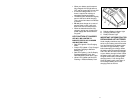
6
Important Rules for Battery
Tools
■ Battery tools do not have to be
plugged into an electrical outlet;
therefore, they are always in
operating condition. Be aware of
possible hazards when not
using your battery tool or when
changing accessories. Following
this rule will reduce the risk of
electric shock, fire, or serious
personal injury.
■ Do not place battery tools or
their batteries near fire or heat.
They may explode. Following this
rule will reduce the risk of electric
shock, fire, or serious personal
injury.
■ Do not charge battery tool in a
damp or wet location. Following
this rule will reduce the risk of
electric shock, fire, or serious
personal injury.
■ Your battery tool should be
charged in a location where the
temperature is more than 50°F
but less than 100°F. Following
this rule will reduce the risk of
electric shock, fire, or serious
personal injury.
■ Under extreme usage or
temperature conditions, battery
leakage may occur. If liquid
comes in contact with your skin,
wash immediately with soap and
water, then neutralize with
lemon juice or vinegar, If liquid
gets into your eyes, flush them
with clean water for at least 10
minutes, then seek immediate
medical attention. Following this
rule will reduce the risk of serious
personal injury.
Important Safety Instructions
For Charger
■ Save these instructions. This
manual contains important
safety and operating
Instructions for battery charger
part number 9
-11040
(981399-001).
Following this rule will reduce the
risk of electric shock, fire, or
serious personal injury.
■ Before using battery charger,
read all instructions and
cautionary markings in this
manual, on battery charger, and
product using battery charger.
Following this rule will reduce the
risk of electric shock, fire, or
serious personal injury.
■ To reduce risk of injury, charge
only nickel-cadmium and nickel
metal hydride type recharge
able batteries. Other types of
batteries may burst causing
personal injury and damage.
Following this rule will reduce the
risk of electric shock, fire, or
serious personal injury.
■ Do not expose charger to rain or
snow. Following this rule will
reduce the risk of electric shock,
fire, or serious personal injury.
■ Use of an attachment not
recommended or sold by the
battery charger manufacturer
may result in a risk of fire,
electric shock, or injury to
persons. Following this rule will
reduce the risk of electric shock,
fire, or serious personal injury.
■ To reduce risk of damage to
charger body and cord, pull by
charger plug rather than cord
when disconnecting charger.
Following this rule will reduce the
risk of electric shock, fire, or
serious personal injury.
■ Make sure cord is located so
that it will not be stepped on,
tripped over, or otherwise
subjected to damage or stress.
Following this rule will reduce the
risk of serious personal injury.
■ An extension cord should not be
used unless absolutely necessary.
Use of improper extension cord
could result in a risk of fire and
electric shock. If extension cord
must be used, make sure:

















